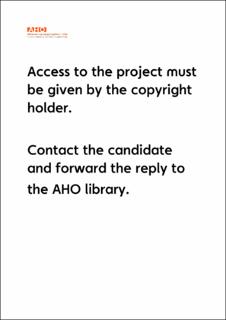| dc.description | The focus of this project is coexistence. Not only how we design buildings to coexist
within our own human societies, but also how this concern may be extended to facilitate
the existence/dwelling of other species.
The topic is investigated through photography, drawings, models, and text.
The result is a strategy for wetland restoration at the former airport in Karlstad that today
is a drained grass field. I have chosen to design a building for the kayak association and
visitor facilities. The wetland will reintroduce a habitat for local wildlife.
The inquiry enters the discourse of how architecture can work as an intersection
where the city meets a natural phenomenon. The phenomenon in this case is the river
Klarälven, where it flows through Karlstad and meets the lake Vänern. The proposal deals
with spaces as well as species. City and wilderness.
Building, dwelling and living along a river means to be in constant negotiation with
water. A river is plastic force that runs through the landscape, changing with the season
and the climate. We have learned to tame our rivers and drain our wetlands with the help
of machines and technological interventions, and many have slowly become domesticized
and controlled by humans.
Except for the mountain areas, 80% of the wetlands in Sweden are managed by
hydrological systems. Damaged wetlands means a loss of habitat for many species,
and display other reduced ecological functions like CO2 storage , rinsing water, flood
prevention and biological production.1 Technical interventions such as timber industry
and hydropower technology have greatly reduced the wild animal kingdom during
the past 200 years. As a result of human exploitation of nature globally, the biomass
distribution index in 2018 has left wildlife vastly outnumbered by humans and domestic
animals.2 This project aims to adress this global issue with a local gesture in Karlstad,
providing better living conditions for wild animals, even in close proximity with humans.
1 11.11.2020 http://sverigesmiljomal.se/miljomalen/myllrande-vatmarker/
2 https://www.pnas.org/content/pnas/early/2018/05/15/1711842115.full.pdf | en_US |




